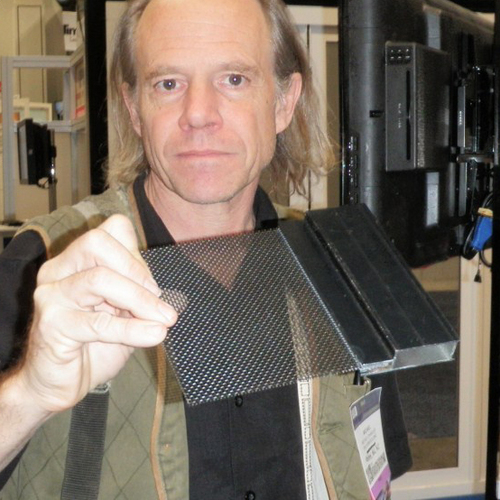Image Credit: Michael Chandler
Image Credit: Michael Chandler Giving testimony in front of this crowd is a pretty intimidating experience.
Image Credit: Michael Chandler A sea of nerds: code officials, lobbyists, governmental officials.
Image Credit: Michael Chander
The ICC hearings last week were packed with building inspectors and government officials who received grant funding — both to join the ICC (so they could vote) and to cover the cost of transportation, food and lodging for the trip. Together they managed to vote in a new code that aims for a 30% reduction in energy usage compared to the 2006 code. Voters who were more interested in affordable housing than energy efficiency never had a chance, though the debates were long and redundant. (For example, the blower door test mandate was debated on five separate occasions.)
Here’s what was accomplished:
- The maximum window U-factor was decreased from U-0.35 to U-0.32 for zones 5-8.
- The maximum window solar heat gain coefficient was decreased from 0.35 to 0.30 in zones 1-4.
- In zones 3-5, the wall insulation requirement was increased from R-13 to R-20 (or R-13 cavity + R-5 sheathing).
- In zones 6-8, the wall insulation requirement was increased from R-20 to R-20 cavity + R-5 sheathing or R-13 cavity + R-10 sheathing.
- The attic insulation requirement was increased from R-30 to R-38 in zones 2-3, to R-49 in zones 4-6, and to R-60 in zones 7-8.
- Crawl space walls must now be insulated with a minimum of R-13 cavity insulation or R-10 continuous in zones 3-4 and R-15 continuous in zones 5-8.
- R-3 pipe insulation is now mandatory on hot-water pipes in unconditioned space or under slabs, on all hot-water pipes with a diameter of 3/8″ or more if the pipe is longer than 30 feet, on all hot-water pipes with a diameter of ½” or more if the pipe is longer than 20 feet, on all hot-water pipes with a diameter of ¾” or more if the pipe is longer than 10 feet, and on all hot-water pipes with a diameter greater than ¾” if the pipe is longer than 5 feet.
- High efficiency light bulbs (LED or fluorescent) must now be installed in 75% of permanent fixtures.
- Trade-offs are not allowed that permit the installation of high-efficiency HVAC equipment to offset energy losses due to envelope features like excessive glazing (encouraging modern-style glass “art homes” to use even bigger well-insulated windowless “art storage rooms” to trade-off in volume what they lack in common sense).
Very significantly, the IECC and the IRC were brought into alignment by replacing Chapter 11 of the IRC with a reference to the IECC. This allows the code to be the same from town to town, even if local inspectors don’t enforce the code equally.
Enforcement will continue to be an issue, as the new code includes new testing requirements.
Duct tightness will now need to be verified at rough-in, with a maximum duct leakage of 6 cfm per hundred square feet of conditioned floor area, unless the ducts and equipment are completely inside the conditioned envelope. To get a Certificate of Occupancy, the post-construction test threshold is 8 cfm/100 sf of conditioned area.
A 2,000-square-foot house with two air handlers will take some time to test, especially at rough-in, and doing it twice will be costly. This is a good standard, but bringing every builder in America up to speed on it will be a challenge. Previously duct testing to12 cfm/100 sf had been an alternative to the thermal bypass inspection; now it’s in addition to the thermal bypass inspection.
Here’s the kicker
After the house is complete and just before occupancy, homes will need to be blower-door tested, with maximum air leakage of 3 ac/h @ 50 Pascals in zones 3-8 (San Antonio to Seattle, Savannah to Concord, and all points in between) and 5 ac/h @ 50 Pascals in zones 1-2. A house or multifamily building that can’t meet the required threshold will not get a certificate of occupancy.
I’m not sure how building inspectors are going to deal with folks who have well insulated, occupancy-ready homes that fail to meet this threshold, especially considering that current Energy Star builders only need 6 ac/h-50. I argued for 5 ac/h-50 nationwide. This is a significantly tighter standard.
Perhaps the inspector will allow a builder who fails a blower-door test to remove some siding and caulk the bottom plates again from the exterior, and perhaps re-tape the sheathing or try to re-seal the ceiling. I saw a lot of building inspectors raising their hands to vote in favor of this. What will they do when faced with a well-insulated house with a drafty mudsill and an anxious builder and homeowner?
Like the equipment trade-off rescission, the blower-door requirement rewards builders who build larger homes. It’s a lot easier to hit 3 ac/h-50 in a 6,000-square-foot McMansion with high ceilings, bonus rooms, and spray foam than it is in a 1,200-square-foot affordable home on a slab.
Exciting days ahead
This is an exciting development, and the
Weekly Newsletter
Get building science and energy efficiency advice, plus special offers, in your inbox.
















3 Comments
ICC Infiltration Standard
3 ach50 is a good target for all new homes and is easily achievable, this level of airtightness will work with the new insulation guidelines and deliver some failrly decent efficiency. The R-2000 program called for 1.5 ach50 and that is not a stretch if you pay attention to air sealing details.
Implementation
When will these new codes take effect such that all homes built after that date will have to meet these standards?
Response to Chris B
Chris,
Once a model code is published, it's up to local jurisdictions to adopt the code if they want. Code adoption varies widely from one place to another. In many areas, codes are adopted on a state-wide level, but some cities (such as Chicago) have always had their own code.
Some areas of the country still have no building codes at all for residential construction.
Finally, even areas of the country that adopt codes don't always enforce them.
Log in or create an account to post a comment.
Sign up Log in